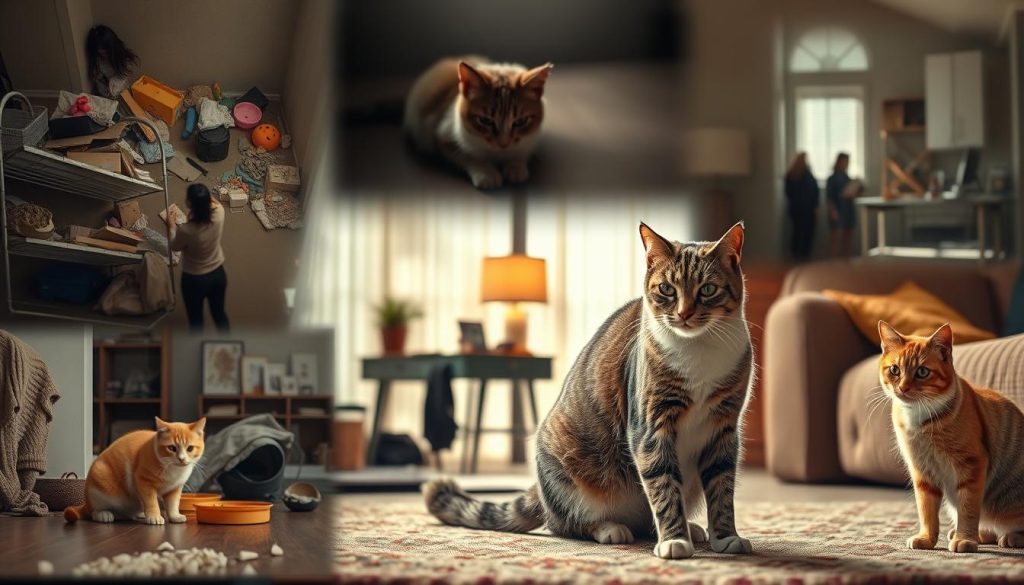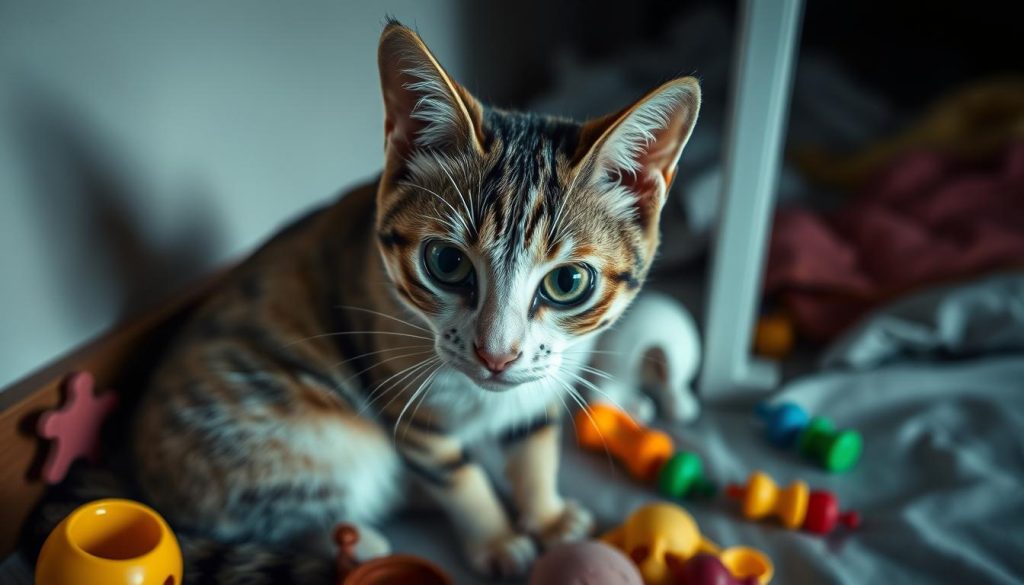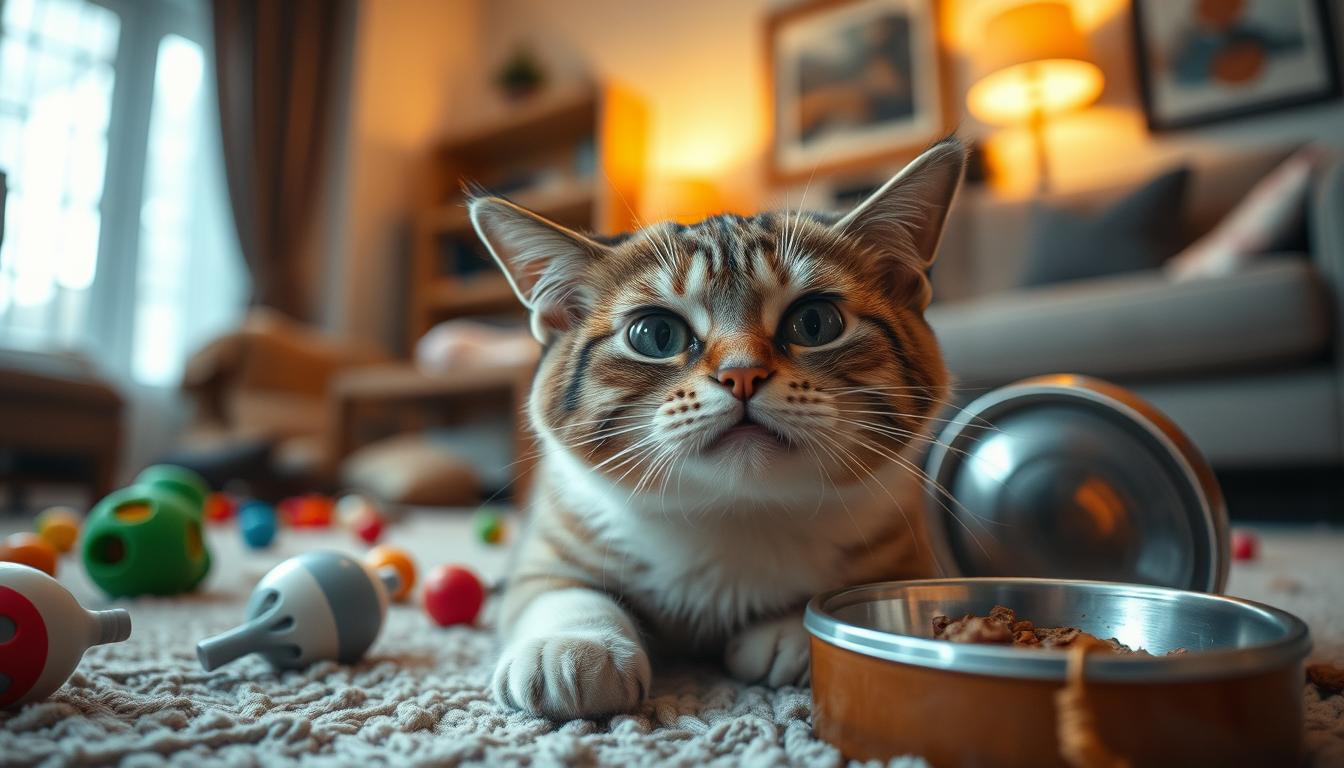I’m excited to share the world of cat behavior problems with you. As a professional copywriter and animal behavior enthusiast, I’ll cover the most common feline quirks. We’ll look at their causes and find effective solutions for a happier home.
Cats are mysterious and have their own unique personalities. Their independent nature is charming but can also cause problems. By understanding these issues, we can improve our bond with them.
If your cat is scratching furniture, peeing where they shouldn’t, or showing aggression, this guide is for you. You’ll learn how to handle these common problems. By the end, you’ll know how to create a peaceful space for you and your cat.
Common Cat Behavior Issues
As pet owners, we often find ourselves puzzled by our feline friends’ peculiar behaviors. Two of the most common cat behavior problems are scratching furniture and inappropriate urination or marking. Understanding the underlying reasons behind these issues can help us address them effectively and maintain a harmonious relationship with our beloved cats.
Scratching Furniture
Cats have an innate need to scratch. They use this behavior to remove the dead outer layer of their claws and mark their territory. Providing your cat with appropriate scratching posts or pads can help redirect this natural instinct and prevent damage to your furniture. Ensure that the scratching surfaces are tall, sturdy, and made of materials that appeal to your cat, such as sisal or cardboard.
Inappropriate Urination or Marking
Feline elimination problems, such as urinating outside the litter box or marking territories, can be a frustrating issue for cat owners. These behaviors may stem from a variety of causes, including stress, medical conditions, or an aversion to the litter box. Addressing the underlying cause, ensuring a clean and appealing litter box, and providing ample opportunities for your cat to mark their territory in appropriate ways can help resolve these cat litter box issues and cat marking behavior.
Understanding the motivations behind these common cat scratching and feline elimination problems is crucial for finding effective solutions and maintaining a harmonious relationship with our feline companions. By addressing these behavior issues proactively, we can create a comfortable and enriching environment for our cats to thrive.
Causes of Cat Behavior Problems

Figuring out why cats act out is key to solving the problem. As a professional copywriter, I’ll look at what makes cats misbehave. This includes health issues, stress, and changes in their environment. Understanding your cat’s needs can help a lot.
Medical problems often cause cat behavior issues. Issues like urinary tract infections or digestive problems can make cats pee in wrong places or get aggressive. It’s important to check with a vet to see if health problems are causing the behavior.
Stress is another big reason for cat behavior problems. Changes like a new family member or moving can stress cats out. This stress can lead to behaviors like meowing too much, grooming too much, or even being destructive.
- Not enough mental stimulation or resources like litter boxes and scratching posts can also cause problems.
- Stress from other pets or loud noises can make cats even more anxious, leading to bad behavior.
| Potential Causes of Cat Behavior Problems | Impact on Feline Behavior |
|---|---|
| Medical Issues | Inappropriate urination, aggression |
| Stress and Environmental Changes | Excessive meowing, over-grooming, destructiveness |
| Lack of Mental Stimulation | Boredom, attention-seeking behaviors |
Knowing why cats behave badly is the first step to fixing it. By tackling the root causes, you can make your cat happier and more secure. This way, they can better handle their surroundings.
Recognizing Signs of Distress

As cat owners, it’s key to notice the small signs our feline friends show when stressed. By knowing the common signs of cat behavior changes, we can spot and fix any issues fast. This keeps our furry friends happy and healthy.
Changes in Grooming Habits
A stressed cat often changes how they groom themselves. Cats usually take great care in their grooming. But when stressed, they might ignore their grooming, leading to a messy look, more shedding, or bald spots.
Excessive Meowing or Yowling
Cats meow and yowl to tell us what they need or how they feel. If your cat is meowing or yowling a lot, it could mean they’re stressed or have a health problem. It’s important to find out why.
| Sign of Distress | Possible Causes |
|---|---|
| Changes in Grooming Habits | Stress, anxiety, medical condition |
| Excessive Meowing or Yowling | Stress, anxiety, medical condition, attention-seeking behavior |
Watching your cat closely and noticing changes in their body language helps you understand their stress. This way, you can make sure your cat is okay and strengthen your bond with them.
Cat Behavior Problems: Aggression
Aggressive behavior in cats can be a big challenge. It can be dangerous for both the cat and its owners. But, by understanding why it happens and taking action, we can solve it. This ensures everyone’s safety and happiness.
Dealing with Aggressive Behavior
Feline aggression comes from many reasons like fear, territorial instincts, or not being socialized. Finding out why the cat is aggressive is key. For fear-driven aggression, creating a safe space is crucial. Gradually introducing new things helps build trust.
When dealing with an aggressive cat, safety is top priority. This might mean positive training, enriching the environment, or getting help from a behaviorist. By tackling the root causes and using a detailed plan, we can manage aggression. This helps create a peaceful bond between the cat and its family.

